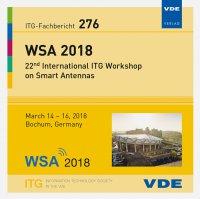Massive MIMO Channel Performance Analysis Considering Separation of Simultaneous Users
Conference: WSA 2018 - 22nd International ITG Workshop on Smart Antennas
03/14/2018 - 03/16/2018 at Bochum, Deutschland
Proceedings: WSA 2018
Pages: 6Language: englishTyp: PDF
Personal VDE Members are entitled to a 10% discount on this title
Authors:
Aslam, Mohammed Zahid; Corre, Yoann (SIRADEL, Rennes, France)
Bjoernson, Emil (Department of Electrical Engineering (ISY), Linköping university, Sweden)
Lostanlen, Yves (SIRADEL North America, Toronto, Ontario, Canada)
Abstract:
One of the key aspects of massive MIMO (mMIMO) is its ability to spatially differentiate between multiple simultaneous users. The spatial separability improves as the number of base station (BS) antenna elements is increased. In real BS deployments, the number of BS array elements will be fixed, and expected to provide the required service to a certain number of simultaneous users in the existing propagation environment. The mMIMO performance is investigated in this paper, in an urban macro-cell scenario, using three kinds of channel models with different complexity levels: the independent and identically distributed Rayleigh fading model, a geometry-based stochastic model, and a physical ray-based software. Two performance indicators are analyzed: the favorable propagation metric and the multi-user eigenvalue distribution. Two frequencies (2 GHz and 28 GHz) and two antenna array shapes (linear and circular) are considered and compared.


